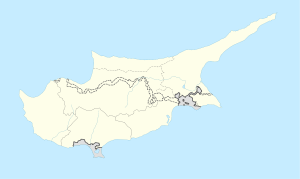Aglandjia
|
Aglandjia Aglantzia |
||
|---|---|---|
 |
||
|
||
| Location in Cyprus | ||
| Coordinates: 35°08′45″N 33°23′25″E / 35.14592°N 33.390169°ECoordinates: 35°08′45″N 33°23′25″E / 35.14592°N 33.390169°E | ||
| Country | Cyprus | |
| District | Nicosia District | |
| Government | ||
| • Type | Municipality | |
| Population (2011) | ||
| • Total | 20,783 | |
| Time zone | EET (UTC+2) | |
| • Summer (DST) | EEST (UTC+3) | |
| Postal code | 4700 | |
| Website | http://www.aglantzia.org.cy | |
Aglandjia (Greek: Αγλαντζιά [locally [aɣlaˈnd͡ʒa]]; Turkish: Eğlence) is a suburb and a municipality of Nicosia, Cyprus. The municipality has a population of 20,783 (2011) and is contiguous with Nicosia Municipality.
Aglandjia is near the buffer zone. It has an area of about 31 square kilometers (km²), of which 14 km² are agricultural land occupied by the Turkish army since 1974. Of the remaining 17 km², 9 km² are national forest parks (Athalassa park [8.6 km²] and Pedagogical Academy park [0.4 km²]).
The word Aglandjia is of Turkish origin, deriving from eğlence, meaning "entertainment". Its pronunciation in Cypriot Greek is [aɣlaˈnd͡ʒa].
Aglandjia is Nicosia's highest suburb, since its largest part is built either on hills or on hillsides or at tableland level. Aglandjia was built in mediaeval times, before Ottoman rule, on an important site for defensive purposes, the existence of natural resources and its healthy climate.
The natural environment of Aglandjia is unique, being not only endowed with the big lung of Nicosia, Athalassa Forest, but also with Ayios Yeoryios park, Aglandjia Municipal park, as well as 45 small parks and green spaces. Aglandjia is built along the road, which led from Nicosia to Larnaca before the invasion. Two trapezoid hills overlook the site on both sides. The hill on the left is Arona hill, which is now under Turkish occupation. The trapezoid hill on the right of the road is called Aronas of Athalassa or Mount Lion or Liontarovounos, on which the remains of the medieval La Cava castle stand.
The history of Aglandjia goes back as far as 3888 BC, since several tombs dating to the Bronze Age were found on the trapezoid Arona hill (Mount Lion or Liontarovounos). Around the hill there was an ancient settlement, from which the city of Ledra may have originated. The Kafizin (in the buffer zone) or Small Aronas, a historic site with a cave dedicated to the worship of a Nymph, where important archaeological works of art and inscriptions in the cypriot syllabary were found, also stands within the area of Aglandjia.
...
Wikipedia


